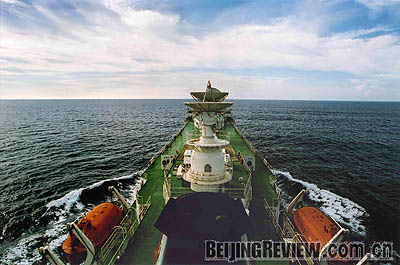|

NAVIGATION: China's Yuanwang ocean survey vessel monitors the position of Shenzhou 6 spacecraft
At the opening ceremony of the Beijing Olympic Games, China's four great inventions-gunpowder, compass, papermaking technology and the art of printing-formed a major part of the celebrations to introduce the country to the world.
As important contributions of the Chinese nation to world civilization, the four ancient inventions have left an indelible mark on humanity. But to what extent have they impacted on China's development and related industries?
Gunpowder
According to China's historical data, gunpowder was invented as early as in the first century B.C. but was then used to make medicine only for perpetual rejuvenation. Black gunpowder was not invented until the end of the ninth century. It was first used to make fireworks, and later lighting fireworks became a Chinese tradition to celebrate festivals. Black gunpowder was used in weapons at the end of the 10th century, when firearms such as exploding arrow heads, flintlock rifles and cannons became available on a large scale. By the end of the 18th century when Western powers invaded China, the Chinese troops were still using flintlock rifles and cannons.
In the 13th century, gunpowder was brought into Arab countries via India by merchants, and then made its way to Europe via Spain by Arabians. Firearms played an important role in Europeans' fight colonial wars.
In the 17th century, gunpowder began to be used in mining and made it possible to explore minerals on a large scale, driving the development of modern mining and smelting industries. In this way, gunpowder also pushed forward the development of global industries as a whole.
In the 19th century, black gunpowder was no longer used for military purposes in Europe, but mainly in mining and making fireworks.
The mining industry has always been one of China's pillar industries. According to the National Bureau of Statistics, in 2007, China's fixed assets investment in the industry totaled 527.1 billion yuan ($76.72 billion), up 26.9 percent compared with the same period of the previous year. Moreover, the mining industry has become a major target of foreign investment. Thus far, more than 100 foreign mineral companies have invested in the Chinese mineral exploration and excavation industry.
Fireworks manufacturing has remained a large industry in China. According to the International Fireworks Association headquartered in Liuyang, China's Hunan Province, there are over 7,500 fireworks producers
| 